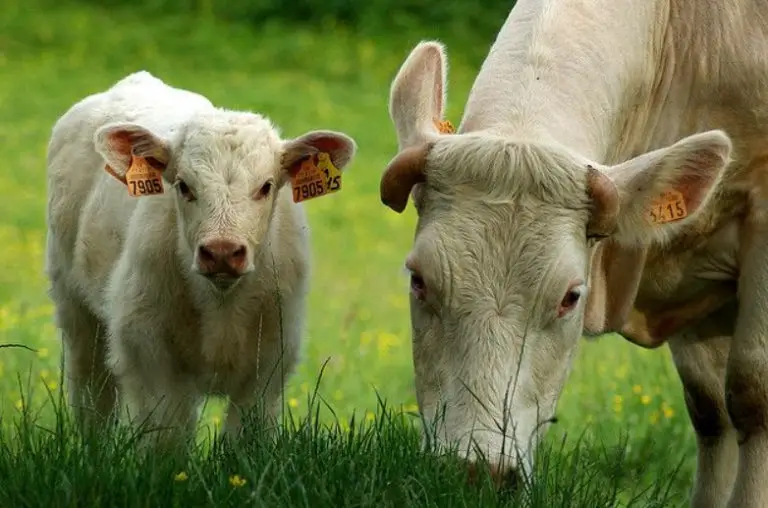No products in the cart.
Cow
Drop Calves: All You Should Know
While dropping a calf is a common term for ranchers on cattle farms, its true meaning might be interesting for people who aren’t familiar with cattle breeding. So, what are drop calves, their roles in the industry, and how to take care of these little creatures?
*This post may have affiliate links, which means I may receive commissions if you choose to purchase through links I provide (at no extra cost to you). As an Amazon Associate I earn from qualifying purchases. Please read my disclaimer for additional details.
What Are Drop Calves?
In agriculture, “drop calves” are baby cows who are separated from their mother cows. Since they compete with their mother’s milk, they bring no profit to dairy farmers. This makes them an unnecessary cost to the industry.
Along with “old” or “worn out” cows whose milk production has slacken, these calves are marketed at stockyard auctions. Their life will end up in pet foods or produce cheap frozen dinners on TV. Or, they might be killed for animal rennet, an enzyme to make cheese.
When Do Cows Drop Calves?
After understanding the “calf drop” meaning, you might be curious to know what the best time of the year to drop the calves is.
In agriculture, choosing when to calve tremendously affects farm production cost, animal performance, and rancher’s income and profitability.
Although some small farms choose spring as their calving season, fall (from September to November) is becoming the ideal season for almost all beef farms with many advantages.
- First, fall calving benefits from consistent weather conditions. Cows that are calved in the fall have fewer risks of getting sick or die of high moisture.
- Second, beef cows at this time of the year have high reproductive performance. Their bodies are now in excellent condition for calving and require less care and maintenance than in spring.
- Third, due to the low calf supply in spring, weaned calves sold in spring markets have a higher price tag of 10-12 cents per pound.
However, there are some disadvantages of fall calving related to forage and feed costs. Forage for the late warm season is lacking nutrition, while forage for the cool season hasn’t been available yet to meet your herd’s demands.
Besides, you will need to increase the winter feed costs for your herd. While summer forage goes dormant, you need to give them sufficient energy and protein intake to maintain their high-quality milk production.
When To Breed For Fall Calves?
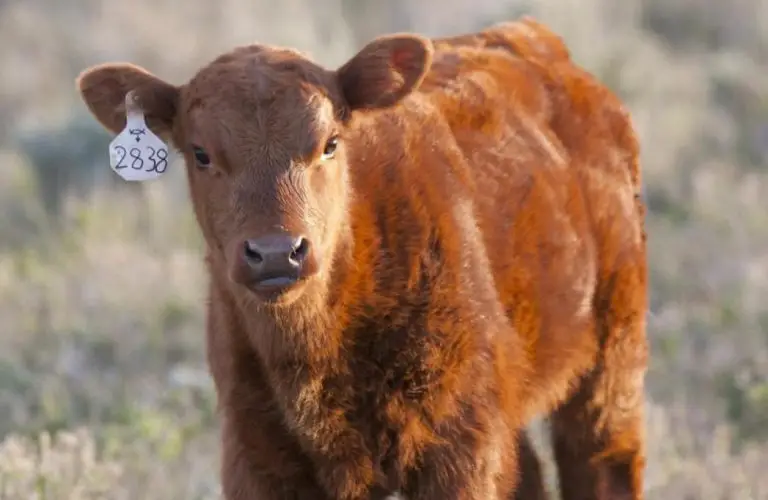
The best time for breeding cows is between November and February.
The extreme high temperature and humidity in the summer months can cause heat stress, which is the main reason that reduces the success of pregnancy in both female cows and bulls.
In female cows, heat stress results in hormone imbalances, which badly affect the quality of ova, cause early embryo death, and reduces the blood flow to the uterus. In bulls, heat stress lowers the quality of sperm cells.
Therefore, you should start breeding your fall calves in the winter months between November and February. However, you should adjust your herd management by supplying cows and bulls with a proper diet with essential nutrition. You should also make the temperature not so stressful so that your cattle can feel comfortable for breeding.
How To Tell When A Cow Is Going To Have A Calf?
There are several signs within 24 hours of calving to help you detect if a cow will have a calf or not, including the relaxation of the pelvic ligaments, strutting of the teats, and other behavior changes.
However, these signs aren’t applied equally and precisely on all cows.
1. The pelvic ligament
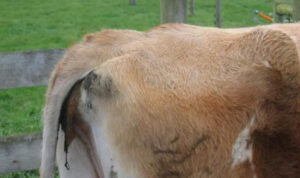
The relaxation of the pelvic ligaments can be used as a clue to calculate the calving time within 12 to 24 hours. While this sign can be observed clearly on thin and moderate cows, it’s hard to see fat cows with body conditions equal to or over 7.
2. The teats’ strutting
The strutting of the teats isn’t a reliable sign for all cows. For example, cows with a heavy milking condition can have strutting of the teats from 2 to 3 days before calving, whereas thin cows with poor milking can calve without having this sign.
3. Changes in behavior
Apart from these two popular signs, there might be some changes in cows’ natural behaviors within 12 hours before calving. For instance, they might not want to eat or prefer to stay alone in the pasture corner. However, only a few of them have these changes.
The herd manager is the only one that knows the exact calving time of his herd. Even a casual observer or a knowledgeable veterinarian who doesn’t see the cows frequently can’t say it. You should watch your cows several times per day and notice the above signs to know when your mother cows are about to have a calf.
How Long Do Calves Stay With Their Mothers?
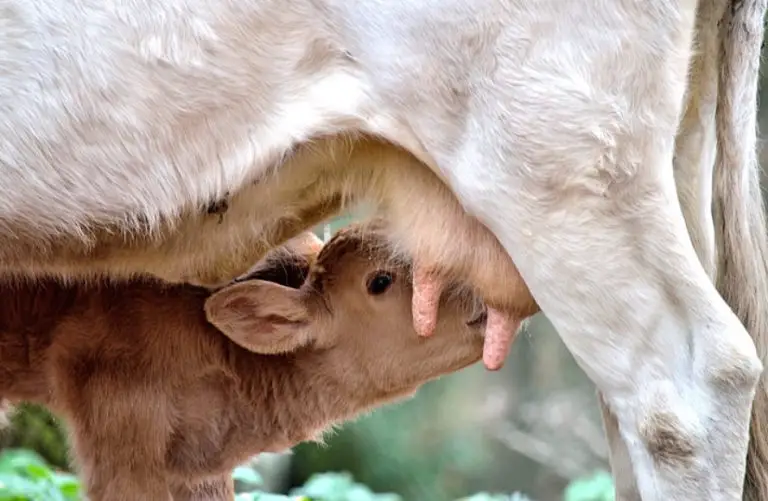
Separating calves from their mother is a difficult time. The timing with their mothers depends on whether the calves are for meat or milk production.
Beef calves
Calves in the beef industry stay with their mothers from 3 to 8 months until their weaning day. Sometimes this time comes early when the calves are ill, or the cattleman needs to cull his livestock for a reason.
Beef calves should be vaccinated 3 to 4 weeks before weaning to reduce weaning stress to their immune system.
Milk calves
Baby dairy cows only stay with their mothers within 24 hours after birth. This early separation helps lessen the stress and response between mother cows and their calves, leading to adverse effects on the calf’s immune system.
Additionally, this separation also helps reduce the exposure to disease to calves, maintain adequate colostrum and feed intake, and help the herd owner detect possible diseases easier.
Finally, this separation on milk calves also eases the facilitate milking and herd management.
Caring Drop Calves
1. Feeding
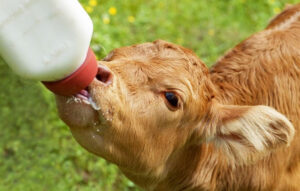
Sanitation is important to maintain the calf’s health and reduce their risk of diseases. Right after calves are born, clean the mother cow’s teats before the calves nurse or separate the calves from the maternity area for cleaning. Also, feed these baby cows high-quality colostrum as soon as possible.
In the following days in their preweaning period, feed the calves with fresh and clean starter food, calf milk replacer, and water daily. Water should be refilled at least twice daily and put outside the pen to avoid contamination.
The calves’ daily diet should be nutritious and of high quality to maintain their healthy growth rate and avoid calving delays.
2. Bedding
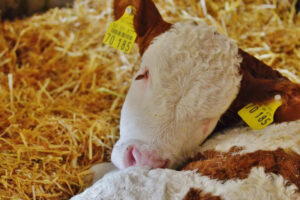
Bedding is where calves stay throughout their pre-weaning period. So, make sure that it’s always comfortable for them to reduce their stress and risks of disease and stay clean while on their herd.
Make a calf’s bedding from straws, shavings, sand, gravel, or sawdust. To maintain a cozy and clean living space for baby cows, regularly check and change their bedding to keep it free of soil, manure, moisture, and pathogens.
Also, replace bedding between two calf generations and use separated equipment between pens and cattle to maintain the farm’s cleanliness and avoid disease transmission.
3. Housing
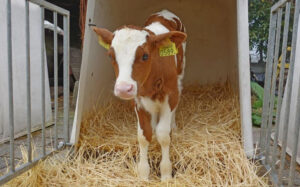
Calf housing should be kept away and have a separated ventilation system from the main dairy housing. It should protect the calves from severe weather elements, have easy access to food and water, and be accessible for frequent cleaning and sanitizing.
If you keep calves in greenhouses, check and adjust the indoor temperature and quality.
Grouping calves can be problematic, especially for new farm owners and those with little experience in the field. You can group post-weaned calves by their ages and sizes, with 3 to 5 heads per group.
When the calves are 4 months old, you can keep 6 to 12 heads per group. However, 3-month-old calves should be separated from older ones to avoid disease transmission.
You should keep the housing’s size small and separated. Calves of different ages in large housing have a higher chance to suffer from respiratory problems or diarrhea.
4. Prevent diseases
Frequent cleaning is a simple and effective way to prevent diseases and discomfort in calves. Follow these simple steps to clean the calf’s housing:
- Move pens and hutches to a clean area.
- Clean all manure, bedding, and feed in the housing. Notice the floor and the alleys between calf pens since there might be a lot of disease-causing organisms in those areas. Avoid using power washers since these machines can help spread pathogens.
- Soak water evenly on all surfaces to remove dried organic objects, then rinse them with alkaline soap and water.
- Soak or foam them again with acid cleaner, then rinse them again.
- Let them dry naturally under the sun to kill bacteria.
FAQs
1. When to stop bottle feeding a calf?
Bottle-feeding can be continued up to 16 weeks. But, as long as the calf has been familiar with calf starter food and hay (or pasture), or when they are around 1 month old, you can reduce or stop bottle-feeding them.
2. What to feed calves after weaning?
Post-weaned calves should be fed a variety of calf starter food until 3 months old. You should also provide them with a small amount of high-quality hay.
Then, from 3 to 15 months old, they should be mainly fed with high-quality forage to maintain adequate growth.
Final Words
Calving season is a brutal test of resilience and toughness with long-lasting impacts for cow-calf pairs and their cattlemen. Whether you are an experienced rancher or a new farmer learning to raise cattle, I hope this article has provided valuable information on drop calves and how to raise them properly.
